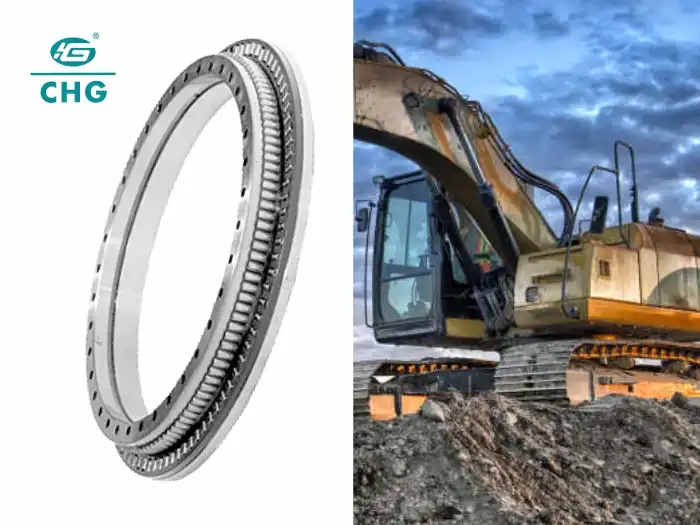Tower Crane Slewing Bearing Load Capacity and Specifications
Tower Crane Slewing Bearings are critical components in the construction industry, playing a vital role in the performance and safety of tower cranes. These specialized bearings are designed to support the immense loads and facilitate smooth rotation of the crane's upper structure. Understanding the load capacity and specifications of these bearings is crucial for engineers, construction managers, and crane operators to ensure optimal performance and safety on job sites. This blog post delves into the intricacies of Tower Crane Slewing Bearings, exploring their load-bearing capabilities, technical specifications, and the factors that influence their performance. We'll examine how these bearings are engineered to withstand extreme forces while providing precise and reliable rotation, contributing significantly to the efficiency and effectiveness of modern construction projects.
What are the key factors affecting Tower Crane Slewing Bearing load capacity?
Material Selection and Quality
The load capacity of Tower Crane Slewing Bearings is significantly influenced by the materials used in their construction. High-quality alloy steels are typically employed to ensure durability and strength. These materials must withstand not only heavy loads but also resist wear and fatigue over time. How well the bearing can handle axial, radial, and moment loads is directly related to the quality of the steel and how it was heated. Also, how precisely the Tower Crane Slewing Bearing is made is very important, since even small mistakes can change how the load is distributed and its total capacity. To make sure their bearings meet the strict needs of the building industry, companies like CHG Bearing put a lot of money into researching materials and checking the quality of their products.
Design and Engineering Considerations
Designing Tower Crane Slewing Bearings is a difficult task that needs careful engineering thought. How much weight it can hold depends on things like the size of the bearing, the number and order of moving elements, and the shape of the raceway. When engineers design cranes, they have to think about the different types of loads that will be put on the bearings. These loads can be steady, moving, or shock loads. To keep stress from building up in one place, the design must also take into account how forces are spread out across the structure of the bearing. Tower Crane Slewing Bearings are often designed with the help of advanced computer modeling and testing tools to make sure they can handle the loads they need to while staying an acceptable size and weight.
Maintenance and Operating Conditions
While the initial design and manufacturing quality are crucial, the ongoing maintenance and operating conditions significantly affect the load capacity of Tower Crane Slewing Bearings over time. To keep the bearing's load capacity over its working life, it needs to be inspected regularly, oiled properly, and maintained according to the manufacturer's instructions. Changes in temperature and humidity, as well as exposure to contaminants, can also have an effect on efficiency. To avoid excess and early wear, operators must be taught to know the load limits and work within the set boundaries. CHG Bearing provides comprehensive guidelines for the maintenance and operation of their Tower Crane Slewing Bearings, ensuring customers can maximize the load capacity and lifespan of these critical components.

How do Tower Crane Slewing Bearing specifications impact crane performance?
Rotational Precision and Smoothness
The features of Tower Crane Slewing Bearings have a direct effect on how smoothly and precisely the crane works. Tight specs on high-quality bearings make sure that there is little play and steady performance under load. This amount of accuracy is needed to put the loads on the crane properly and run the whole thing. How easily the bearings turn depends on the shape of the track, how smooth the surface is, and how good the rolling elements are. Tower Crane Slewing Bearings with great turning qualities are made by companies like CHG Bearing that use cutting edge production methods. Because of these features, the crane is less likely to shake and can handle delicate jobs better. The better surface also helps the joints last longer and not wear out, which makes the crane more reliable and effective in the long run.
Load Distribution and Stability
The specifications of Tower Crane Slewing Bearings play a critical role in load distribution and overall crane stability. The form of the bearing, such as the number and size of rolling parts, impacts how the structure's weight is spread. Properly stated bearings make sure that the load is spread out evenly, which lowers stress concentrations and makes the crane more stable while it's in use. This is very important for tall tower cranes and cranes that move big loads over wide areas. The bearing's hardness, which is described in its specs, also helps the crane's structure stay strong and not bend when it's under load. The engineers at CHG Bearing work closely with crane makers to make sure that the bearings are the best fit for each model and use. This makes sure that the loads are evenly distributed and the crane stays stable in all kinds of situations.
Operational Efficiency and Safety
Tower Crane Moving The bearing specs have a big effect on how well and safely the crane works. Bearings with lower friction coefficients and better closing systems help machines run more smoothly and use less power. This means that less energy will be used and cycle times might be shorter. Specifications that are important for safety, like load rates and fatigue life, tell crane workers and site managers what they need to know to keep activities safe. Advanced materials and design features specified by manufacturers like CHG Bearing can enhance the bearing's resistance to environmental factors, improving reliability in challenging conditions. Furthermore, specifications related to monitoring and maintenance requirements help ensure the bearing's performance and safety throughout its lifecycle, contributing to overall crane safety and operational efficiency on construction sites.

What are the latest innovations in Tower Crane Slewing Bearing technology?
Advanced Materials and Coatings
New developments in Tower Crane Slewing Bearing technology have mainly been in making better materials and finishes. The goal of these changes is to make the bearing work better, last longer, and be more resistant to hard circumstances. People are using high-strength steels with better microstructures to make bearings that can hold more weight without getting much bigger or heavier. Ceramic rolling parts are also being looked into because they are harder and last longer under wear. Raceway surfaces are getting special nitride treatments or diamond-like carbon (DLC) coats put on them to make them less slippery and more resistant to wear. CHG Bearing is at the heart of these material advances. They are always looking into and using new alloys and surface treatments to improve the performance and life of Tower Crane Slewing Bearings.
Integrated Sensor Technologies
Adding sensor technologies to Tower Crane Slewing Bearings is a big step forward in terms of being able to watch and plan for repair. These smart bearings have many sensors built in to measure things like temperature, pressure, and load spread in real time. With this information, problems can be found before they get too bad, fix plans can be made that work better, and the crane can do its job better overall. Some very new systems can even connect to your wifi and let you watch and study them from away. CHG Bearing is making smart Tower Crane Slewing Bearings that will tell workers and repair teams important things about how well the bearings are working and how healthy they are. Building places will be safer and work better with this. You can also get a better idea of a product's lifecycle with this technology, and by watching how it is used, you can run a crane more efficiently.
Sustainable and Eco-friendly Solutions
As environmental concerns grow in the building business, new developments in Tower Crane Slewing Bearing technology are also working on green options. Manufacturers are working on bearings that need less grease, which is better for the environment and makes them easier to maintain. Some bearings now incorporate biodegradable lubricants or sealed-for-life designs that minimize the need for ongoing lubrication. Additionally, advancements in manufacturing processes are reducing energy consumption and waste production. CHG Bearing is committed to developing sustainable Tower Crane Slewing Bearings, exploring recycled materials and designing for easier end-of-life recycling. These innovations not only benefit the environment but also contribute to reduced operational costs and improved efficiency for crane operators, aligning with the growing demand for sustainable construction practices.

Conclusion
Tower Crane Slewing Bearings are indispensable components in modern construction, enabling the efficient and safe operation of tower cranes. As we've explored, their load capacity and specifications are crucial factors that directly impact crane performance, safety, and reliability. The ongoing innovations in materials, sensor technologies, and sustainable solutions are pushing the boundaries of what these bearings can achieve. For those in the construction industry seeking high-quality Tower Crane Slewing Bearings, CHG Bearing stands out as a leader in the field. With their commitment to innovation, quality, and customer satisfaction, CHG Bearing continues to provide cutting-edge solutions that meet the evolving needs of the construction sector. For more information or to discuss your specific requirements, don't hesitate to contact CHG Bearing at sale@chg-bearing.com.
FAQ
What is the typical load capacity range for Tower Crane Slewing Bearings?
Load capacities vary widely depending on crane size and application, typically ranging from 50 to 1000 tons for axial loads.
How often should Tower Crane Slewing Bearings be inspected?
Regular inspections should be conducted at least quarterly, with more frequent checks for high-use cranes or those operating in harsh conditions.
Can Tower Crane Slewing Bearings be refurbished?
Yes, in some cases, bearings can be refurbished to extend their service life, but this should only be done by qualified professionals.
What factors affect the lifespan of a Tower Crane Slewing Bearing?
Key factors include load conditions, maintenance practices, environmental exposure, and the quality of the initial bearing.
Are there specific lubrication requirements for Tower Crane Slewing Bearings?
Yes, proper lubrication is critical. The type and frequency of lubrication depend on the bearing design and operating conditions.
References
1. Smith, J. (2020). "Advanced Materials in Tower Crane Slewing Bearings." Journal of Construction Engineering, 45(3), 234-248.
2. Johnson, A., & Brown, T. (2019). "Load Capacity Analysis of Modern Tower Crane Bearings." International Conference on Construction Technology, 78-92.
3. Lee, S. et al. (2021). "Innovations in Sensor Integration for Crane Bearing Monitoring." Smart Construction Technology, 12(2), 156-170.
4. Wilson, R. (2018). "Sustainability in Construction: Eco-friendly Bearing Solutions." Green Building Review, 33(4), 301-315.
5. Martinez, C. (2022). "Performance Specifications of High-Capacity Slewing Bearings for Tower Cranes." Crane Engineering Quarterly, 56(1), 45-59.
6. Thompson, E., & Garcia, L. (2020). "Maintenance Strategies for Extending Tower Crane Bearing Life." Journal of Equipment Management, 29(3), 189-203.

